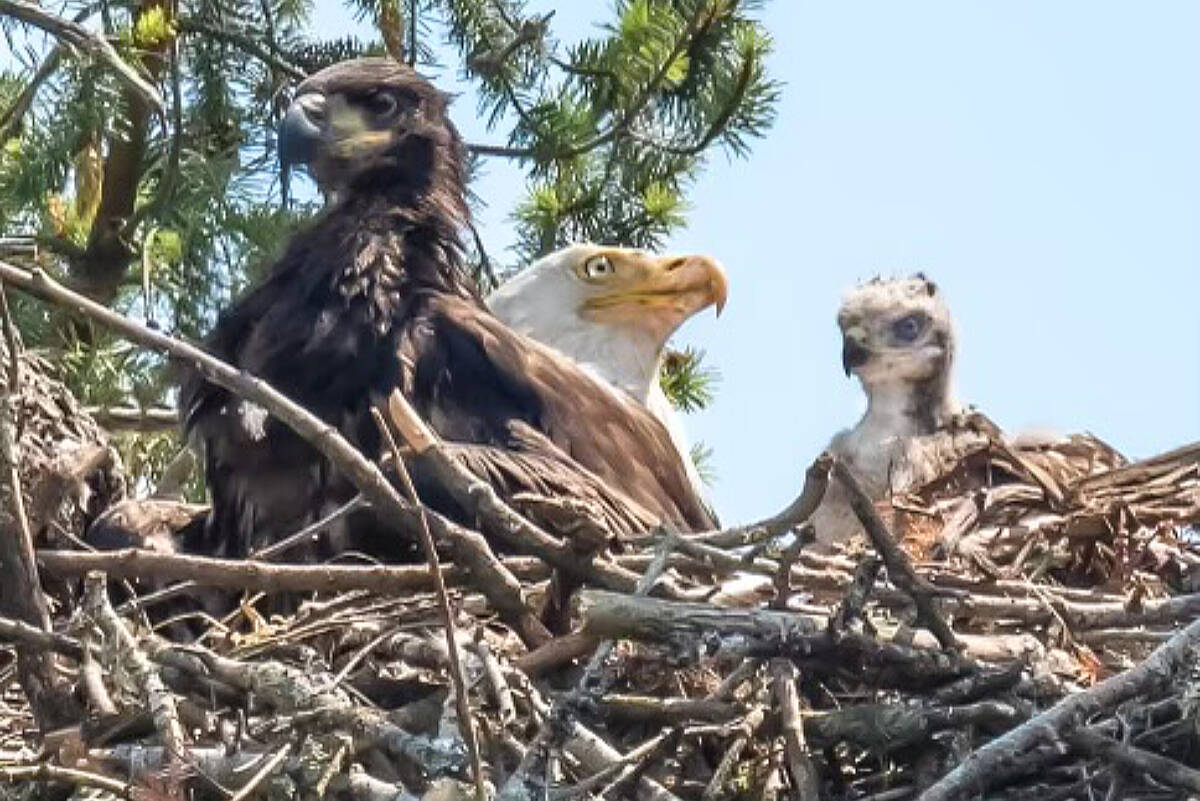A red-tailed hawklet that was supposed to be an eaglet’s dinner has inadvertently become its adopted sibling on a B.C. Gulf Island off Nanaimo.
Pam McCartney, communications director for Gabriola Rescue of Wildlife Society, said the hawklet was dropped in a Gabriola Island eagle’s nest June 4. GROWLS keeps a webcam trained on the nest so the society and members of the public can watch a pair of eagles raise their young each year.
McCartney said she couldn’t tell at first what the female eagle had dropped in the nest.
“She had something kind of big in her talons that looked limp and dead,” McCartney said. “Was it a bird or a fish? What the heck has she got there?”
When the eagle dropped it in the nest the hawklet started moving.
“I thought, ‘oh, my goodness it’s alive. We’re going to have to see something bad,” she said. “So, that was hours of anxiety just watching what was going to happen.”
The little hawk was much smaller than the eaglet it was intended as a meal for, but instead of becoming dinner, over time it started snuggling up to the eaglet. The mother eagle kept coming back to the nest, as if to see if its eaglet was going eat the little hawk, but it never prodded the eaglet to move the situation along.
McCartney said the hawk must have been snatched out of a nest by the eagle. It was a rainy and cold and the hawklet, apparently fearful, would hide in the corner of the nest when the mother eagle was there. When the mother eagle would leave, though, the little hawk would snuggle up toward its eaglet nest mate for warmth.
“By the time nightfall happened, mom was brooding over both of them and sheltering them both from the rain,” McCartney said. “It made me very happy.”
Within the next couple of days the hawklet started cheeping for food and before long the female and male eagle were both feeding the little hawk.
“Now they’re like best friends,” McCartney said. “The hawk’s probably going to fly out of there soon, but they’re a happy family.”
She said the nest site has been there for at least 10 years and the current nest was built by the eagles about five years ago after the previous one collapsed.
She said the hawk was probably dropped in the nest alive in an attempt to teach the eaglet how to kill its own food, but the plan didn’t work out, possibly because the eaglet had a sibling that died and McCartney theorized the eaglet might have associated it with its former nest mate. That bird was pecked at by its sibling and its parents stopped feeding it. It died around mid May.
McCartney said the proper term for a baby hawk is ‘eyas,’ but she prefers to use the layperson’s term ‘hawklet.’
GROWLS members have named the little hawk Malala after Malala Yousafzai, the Pakistani activist for girls’ education and Nobel Peace Prize laureate who was shot by a Taliban gunman in 2012. The name Malala, McCartney said, has become synonymous with ‘survivor.’
How the little hawk will fare when it leaves the nest remains to be seen. McCartney said red-tailed hawks in the wild are a delicacy for eagles.
“So if this hawklet is flying away as a juvenile, thinking eagles are its friends, it could be a quick demise for that poor little hawk,” she said. “We’ll never know.”
To watch the nest on the GROWLS eagle cam, visit http://youtu.be/YSAuhydeTdU. To learn more about GROWLS and its programs, visit www.growls.ca.
READ ALSO: Nanaimo News Bulletin’s top 10 most-memorable animal stories of 2021
READ ALSO: Nanaimo News Bulletin’s top 10 most-memorable animal stories of 2020
READ ALSO: Nanaimo News Bulletin’s top 10 most-memorable animal stories of 2019
photos@nanaimobulletin.com
Like us on Facebook and follow us on Twitter

